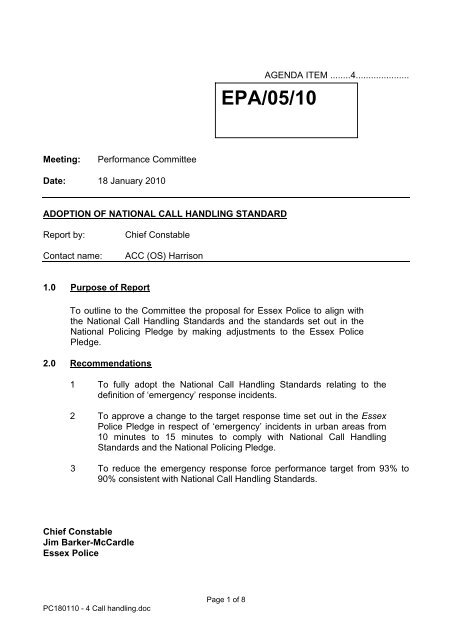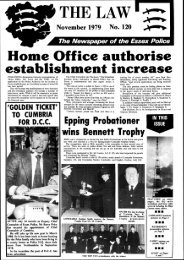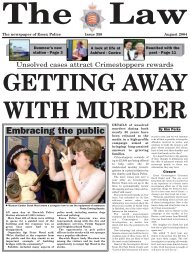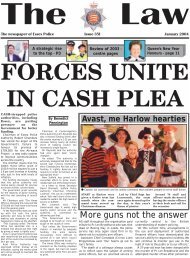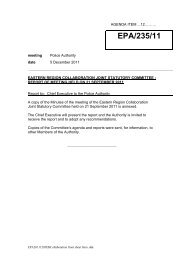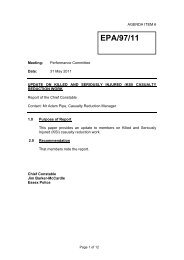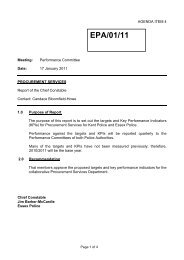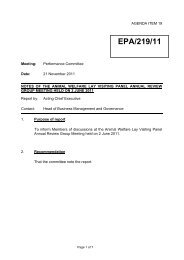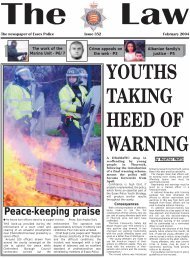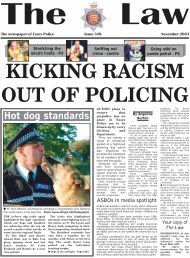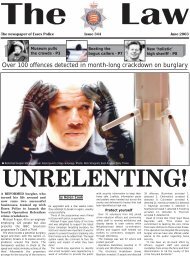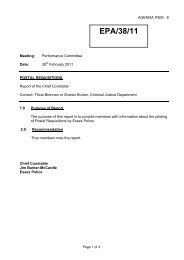EPA/05/10 - Essex Police
EPA/05/10 - Essex Police
EPA/05/10 - Essex Police
You also want an ePaper? Increase the reach of your titles
YUMPU automatically turns print PDFs into web optimized ePapers that Google loves.
Meeting: Performance Committee<br />
Date: 18 January 20<strong>10</strong><br />
AGENDA ITEM ........4.....................<br />
<strong>EPA</strong>/<strong>05</strong>/<strong>10</strong><br />
ADOPTION OF NATIONAL CALL HANDLING STANDARD<br />
Report by: Chief Constable<br />
Contact name: ACC (OS) Harrison<br />
1.0 Purpose of Report<br />
To outline to the Committee the proposal for <strong>Essex</strong> <strong>Police</strong> to align with<br />
the National Call Handling Standards and the standards set out in the<br />
National Policing Pledge by making adjustments to the <strong>Essex</strong> <strong>Police</strong><br />
Pledge.<br />
2.0 Recommendations<br />
1 To fully adopt the National Call Handling Standards relating to the<br />
definition of ‘emergency’ response incidents.<br />
2 To approve a change to the target response time set out in the <strong>Essex</strong><br />
<strong>Police</strong> Pledge in respect of ‘emergency’ incidents in urban areas from<br />
<strong>10</strong> minutes to 15 minutes to comply with National Call Handling<br />
Standards and the National Policing Pledge.<br />
3 To reduce the emergency response force performance target from 93% to<br />
90% consistent with National Call Handling Standards.<br />
Chief Constable<br />
Jim Barker-McCardle<br />
<strong>Essex</strong> <strong>Police</strong><br />
PC1801<strong>10</strong> - 4 Call handling.doc<br />
Page 1 of 8
3.0 Introduction<br />
Current <strong>Essex</strong> <strong>Police</strong> Policy for responding to incidents was written in 2006 and<br />
needs to be amended to ensure the Force complies with National Call Handling<br />
Standards (NCHS) and the standards set out in the National Policing Pledge in<br />
respect of:<br />
• Categorisation of ‘emergency’ and ‘priority’ calls,<br />
• Response time targets for ‘emergency’ and ‘priority’ calls.<br />
The impact of the above will be :<br />
• An enhanced service to the general public, as there will be an increase in the<br />
number of ‘emergency’ calls due to the wider definition within the NCHS,<br />
• A reduction in any perceived pressure to meet response times as Officers will<br />
have slightly longer to get to locations safely,<br />
• More meaningful comparisons of data relating to call handling and response<br />
times with other forces,<br />
• Changes to the <strong>Essex</strong> <strong>Police</strong> Pledge to comply with the National <strong>Police</strong> Pledge<br />
to respond to emergency urban incidents within 15 minutes instead of the<br />
previous target of <strong>10</strong> minutes,<br />
• It will support the Force in delivering the Policing Pledge.<br />
It is proposed that on the revisions being adopted the Force policy will be amended<br />
and the changes also reflected in the 20<strong>10</strong>-11 Force Objectives. See Appendix A<br />
for an extract from the National Contact Management Strategy covering response<br />
grades.<br />
4.0 Current Position<br />
In January 2008, the government launched the National Policing Pledge across all<br />
<strong>Police</strong> Forces. Pledge point 5 (which deals with emergency calls from the public)<br />
requires police officers to attend 90 % of emergency incidents within 15 minutes for<br />
an urban location, and within 20 minutes for a rural location. When the National<br />
Policing Pledge was adopted in <strong>Essex</strong> the response time of <strong>10</strong> minutes for<br />
‘emergency’ response incidents was maintained instead of adopting a 15 minute<br />
target as set out in the National Policing Pledge.<br />
At present, <strong>Essex</strong> <strong>Police</strong> deals with 15 to 25 emergency incidents per day. Under<br />
the wider definition it is anticipated that this number will increase to 130-150<br />
incidents per day. An example of an incident that would be captured within the new<br />
definition would be a minor crime in progress, such as low level criminal damage,<br />
which is currently classified as a ‘priority’ incident. In this respect the public will<br />
receive a more responsive service.<br />
PC1801<strong>10</strong> - 4 Call handling.doc<br />
Page 2 of 8
The table below shows <strong>Essex</strong> <strong>Police</strong> targets against regional 1 compliance with the<br />
NCHS and the National Policing Pledge. For clarity it is proposed that <strong>Essex</strong> moves<br />
to the regional targets shown below.<br />
Category Regional<br />
Time<br />
(minutes)<br />
Regional<br />
Targets<br />
<strong>Essex</strong><br />
Time<br />
(minutes)<br />
<strong>Essex</strong><br />
Target<br />
Emergency Urban 15 90% <strong>10</strong> 93%<br />
Emergency Rural 20 90% 20 93%<br />
Priority Urban 60 90% 20 90%<br />
Priority Rural<br />
30 90%<br />
The table below illustrates current regional comparisons, highlighting <strong>Essex</strong> having<br />
an average of 1.3% of its total incidents graded as emergency compared to the<br />
regional average of 8.3%.<br />
70000<br />
60000<br />
50000<br />
40000<br />
30000<br />
20000<br />
<strong>10</strong>000<br />
0<br />
1.3% 6.7% 9.8%<br />
13.7<br />
%<br />
6.6%<br />
11.8<br />
%<br />
<strong>Essex</strong> Suffolk Herts Norfolk Kent Cambs<br />
Emergency Incidents<br />
All Incidents<br />
Accepting the increase in ‘emergency’ graded incidents and taking into account the<br />
slight reduction in response target time from <strong>10</strong> minutes to 15 minutes, on<br />
numerical analysis only it is predicted that the Force would meet the response times<br />
for urban and emergency incidents 75-80% of the time. Although this is lower than<br />
current performance levels (90.7% against a target of 93%), it would be comparable<br />
to other Most Similar Forces such as Kent whose performance is currently 79%<br />
against a target of 90%.<br />
1<br />
Only <strong>Essex</strong> and Norfolk currently employ the same targets for both emergency and priority responses.<br />
Page 3 of 8<br />
PC1801<strong>10</strong> - 4 Call handling.doc
Performance will be dependent on the number of officers available to be deployed<br />
to the increased number of ‘emergency’ incidents envisaged. If the number of<br />
officers was to increase then performance would tend to improve, similarly if it was<br />
reduced then performance may reduce. Furthermore, officers deployed to<br />
‘emergency’ incidents post any change, may be more inclined to make use of the<br />
blue lights and two tones to make progress. Similarly partners such as Highways<br />
Agency Traffic Officers (HATOs) who jointly respond to incidents on motorways and<br />
major road networks are included in the response time data, with their arrival times<br />
being recorded as an alternative to that of the <strong>Police</strong> if they arrive first.<br />
Although in many ways the public will receive a better service, the perception of<br />
police officers having more time to attend and a slightly lower performance target<br />
will need to be carefully communicated. This is to a degree offset by the significant<br />
and predictable rise in the number of ‘emergency’ incidents, which should be<br />
welcomed as they would previously have attracted a slower response. To this end,<br />
the appropriate context will be provided to the public to help them understand the<br />
changes and benefits that are to be expected, this will be managed through the<br />
Pledge communications plan. Together these improvements will provide greater<br />
compliance to the National Policing Pledge.<br />
It is not anticipated that there should be any changes to the manner in which<br />
performance is monitored and managed. Monitoring will be enhanced by the ability<br />
to make more meaningful comparisons across force groups, and share best<br />
practice.<br />
5.0 Proposals<br />
That <strong>Essex</strong> <strong>Police</strong> Authority support the amendment to the <strong>Essex</strong> <strong>Police</strong> Pledge to<br />
increase the response time for emergency urban incidents from <strong>10</strong> to 15 minutes by<br />
adopting the National Call Handling Standards and definitions as described within<br />
the recommendations. These changes will be implemented on the 1 st April 20<strong>10</strong><br />
and will ensure the <strong>Essex</strong> <strong>Police</strong> Pledge reflects the National Policing Pledge.<br />
6.0 Summary<br />
Nationally, the vast majority of forces currently support the National Call Handling<br />
Standard, as underpinned by the National Policing Pledge. Although <strong>Essex</strong> <strong>Police</strong><br />
has had higher targets and standards than many other forces, this did not comply<br />
with the NCHS or the National Policing Pledge and HMIC commented on this<br />
recently. In aligning with the NCHS and National Policing Pledge, <strong>Essex</strong> <strong>Police</strong><br />
would fully comply with national expectation and this would make comparisons of<br />
performance with other forces simpler and more meaningful.<br />
PC1801<strong>10</strong> - 4 Call handling.doc<br />
Page 4 of 8
Appendix A<br />
Extract from the National Contact Management Strategy<br />
The original National Call Grades (20<strong>05</strong>) were supported by definitions. The<br />
national guidance provides specific definitions around emergency and nonemergency<br />
contact and an understanding of how the Pledge promise can be used<br />
as a set of standards for service that the public can use as a measurement of what<br />
they can expect. Many forces will underpin the national contact grades with a local<br />
approach, for example, their own definitions and narrative, which will have been<br />
designed in conjunction with partners and local communities.<br />
Chief Constable Julie Spence, ACPO Lead for Citizen Focus (2009) stated that:<br />
“The Pledge has at its core the delivery of good service. However good service<br />
cannot be measured by numbers alone and care should be taken to ensure that a<br />
mechanistic service is not the unintended consequence of a restrictive performance<br />
regime. I am aware that some seek specific definitions on all aspects of the Pledge<br />
so that performance against it can be clinically assessed. I urge you to resist the<br />
temptation to approach the Pledge in this way as the provision of poor service<br />
would undoubtedly be the consequence”.<br />
The following grades have been agreed by (will form part of consultation at ACPO<br />
Cabinet). They are not designed to inhibit or restrict force’s local and individual<br />
definitions or responses; they set out a minimum expected response.<br />
National Contact Graded Responses - Critical Success Factors/Guidance:<br />
• Using the contact grades as a framework to prioritise and standardise the<br />
response to calls for service,<br />
• Ensuring that contact handlers understand the importance of using the national<br />
contact grades to prioritise and deliver local needs and expectations.<br />
Emergency/Immediate Contact<br />
An emergency/immediate contact encompasses circumstances where an<br />
incident is reported to the police which is taking place and in which there is or is<br />
likely to be a risk of:<br />
• Danger to life,<br />
• Use, or immediate threat of use of violence,<br />
• Serious injury to a person and/or<br />
• Serious damage to property.<br />
PC1801<strong>10</strong> - 4 Call handling.doc<br />
Page 5 of 8
Where the contact relates to an allegation of criminal conduct, it will be dealt<br />
with as an emergency if:<br />
• The crime is, or is likely to be serious, and in progress,<br />
• An offender has been disturbed at the scene,<br />
• An offender has been detained and poses, or is likely to pose a risk to other<br />
people.<br />
Where the contact relates to a traffic collision, it will be dealt with as an<br />
emergency if:<br />
• It involves or is likely to involve serious personal injury,<br />
• The road is blocked or there is a dangerous or excessive build-up of traffic,<br />
• Where the above circumstances do not apply, a contact will be classified as an<br />
emergency if:<br />
o The circumstances are such that a police contact handler has strong and<br />
objective reasons for believing that the incident should be classified as an<br />
emergency.<br />
An emergency contact will require immediate response in line with<br />
Force deployment priorities.<br />
Emergency/Immediate Response<br />
Where an emergency contact requires an emergency/immediate police<br />
Response, the caller should expect the following as standard:<br />
• The contact handler to give an estimated time of arrival, where appropriate,<br />
getting to you safely, and as quickly as possible,<br />
• In Urban areas, we will aim to get to you within 15 minutes and in rural areas<br />
within 20 minutes.<br />
Non-Emergency Contact<br />
A contact will be classified as non-emergency if it does not meet the emergency<br />
criteria outlined above. The consequences of classifying a contact as a nonemergency<br />
mean only that the police response may not be immediate, and may<br />
encompass a range of solutions, some of which will not require the attendance of<br />
an officer.<br />
A non-emergency contact attracts three levels of initial response:<br />
• Priority/prompt response,<br />
• Scheduled appointment,<br />
• Resolution without deployment.<br />
PC1801<strong>10</strong> - 4 Call handling.doc<br />
Page 6 of 8
Priority/Prompt Response<br />
A priority/prompt response will be required where the police contact handler<br />
acknowledges that there is a degree of importance or urgency associated with<br />
the initial police action, but where an emergency/immediate response is not<br />
required. Where a non-emergency contact requires a priority/prompt police<br />
response; the caller should expect:<br />
• The contact handler to give an estimated time of arrival,<br />
• If you are vulnerable or upset, we will be with you within 60 minutes,<br />
• If you are calling about an issue that we have agreed with your community will<br />
be a neighbourhood priority and attendance is required, we aim to be with you<br />
within 60 minutes.<br />
These typically arise in the circumstances where:<br />
• There is a genuine concern for a person’s safety,<br />
• An offender has been detained but poses no risk to others,<br />
• A witness or other evidence is likely to be lost,<br />
• A person involved is vulnerable or upset,<br />
• Force/neighbourhood priorities require a priority response,<br />
• Hate crime.<br />
Scheduled Appointment<br />
Any contact that does not require an ‘immediate’ or ‘priority’ response but still<br />
requires police attendance, will result in a scheduled appointment response.<br />
These circumstances typically arise where:<br />
• The response time is not critical in apprehending offenders,<br />
• The matter is service–orientated and a better quality of initial police action can<br />
be dealt with by:<br />
o A pre-arranged police response by a suitable police resource,<br />
o Attendance at a police clinic or surgery at a time and location of the caller’s<br />
choice.<br />
Where a non-emergency contact requires an appointment to be scheduled, the<br />
caller should expect the following standards:<br />
• If appropriate, an appointment will be made at a time that fits in with the caller’s<br />
life and within 48 hours of them making contact.<br />
Resolution Without Deployment<br />
Resolution without deployment occurs where the needs of the caller can be<br />
adequately met through provision of advice, information, a helpdesk function or<br />
signposting to another lead agency/service.<br />
PC1801<strong>10</strong> - 4 Call handling.doc<br />
Page 7 of 8
This includes signposting to the <strong>Police</strong> National Legal Database Frequently Asked<br />
Questions (PNLD FAQs) database www.askthe.police.uk .<br />
A non-emergency contact that does not require police attendance will be dealt<br />
with over the phone, the caller should expect the following standard:<br />
• If it is agreed that attendance is not necessary we will give you advice, answer<br />
your questions and/or put you in touch with someone who can help.<br />
PC1801<strong>10</strong> - 4 Call handling.doc<br />
Page 8 of 8


